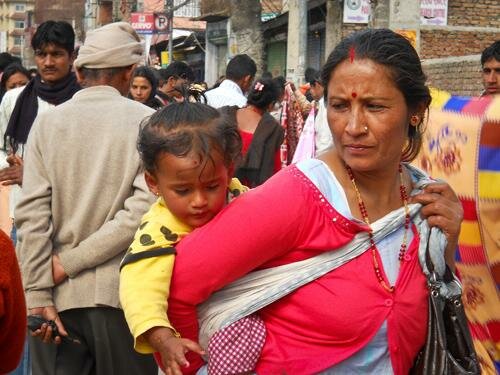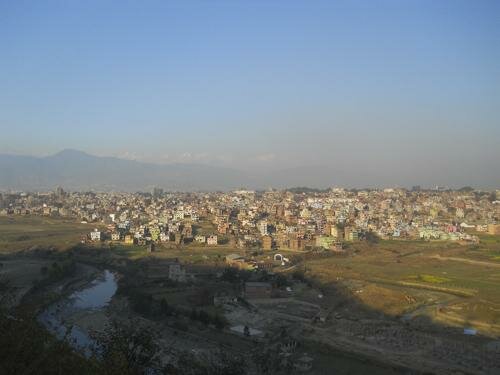Photographic Trigonometry
Between February and March 2011, with the support of The Patatas, I conducted a photography workshop with some 34 students in Nepal, most of which were from underprivileged backgrounds. During the month-long course, students kept a journal of the lessons they learnt and the reflections they experienced. The following comprises expcerpts from one of my students, Samanta Acharya.

By Samanta Acharya
23 Feb 2011: First class started with the basic operation of the camera which was not much new for me, but the way Debby described it was really interesting. She demonstrated how to handle the camera to make it safe in some difficult situations and discussed the limitations and potential of using compact digital cameras. Captions are a really important entity of any photograph. Debby described the importance of captions, and the questions we should answer with the captions like who, what, where and when.
Mathematics came again in the photography class, that is lines, triangles, circles. I was quite astonished at first but later on I got the point that Debby was trying to explain and understood the fundamental shapes of nature and its importance in photography. We were given homework in which we have to bring photographs that show the three fundamental mathematical shapes.
26 Feb 2011: When I came home with the camera, I tried to capture and found out the basic shapes like lines, triangles, circles... as a line, I captured trees and its branches, as a triangle I saw hills, and as a circle I thought to capture flowers and light. I practices capturing pictures in different moods such as landscape, portrait and explored basic shapes in the pictures.
Second class was much more important because I have learned some important rules of photography, such as the rule of thirds, experiencing the moments, observing action, and useful and important things in captions. Debby focused and said that "do not try to look for new places... keep going back to the same place again and again".
28 Feb 2011: My picture was included in Debby's presentation in class. She explained how to capture good images. She suggested that the way to make the picture really better is to keep it balanced, clean, and focused. Clean and focused are quite simple to understand but balance is quite tricky. To keep it balance we have to think of the subjects in the picture and also the colours.
In this class other important things such as the meaning and importance of the lines, triangles, and circle are well explained. She demonstrated that "lines should lead to the subject". Very simple things but I generally ignored such as living things should be captured horizontally and should not be slanted or disoriented.
3 March 2011: At the end of today's class, the best picture from last week's assignment was announced, that was Kriti Hada. Her picture was simple at general look but contains a lot of feelings in it. An old woman just sitting on a bed with her gloomy face... folds on her forehead... serious eyes... Captions said that she was meeting her relatives after a long period and that she was suffering from some kind of heart disease. Kriti stood up in class to further explain about it. She won a book from National Geographic... that's great. Congratulations Kriti, you did a great job!
I found a similarity between Kriti's picture and the winning picture of a photography competition by UNDP Nepal a few months ago. I submitted nine pictures for the disaster-related category. The winning picture was quite similar to Kriti's. There was nothing special at a glace but it evoked similar feelings i.e. a mother with her child feeding at her breast, seating on a bank of Koshi river, with serious face, caption explained that her house was flooded by the Koshi River and she is hopeless at the moment.
Today I have learned that the picture is best if it contained both feelings, emotions at certain moment, with the good quality and technically balanced.

6 March 2011: This week was quite hasty for me. I have to go to Tribhuvan University, Kirtipur several times. Kirtipur is a very small city with lots of crowd concentrated in a very small area. I was quite fascinated with the city and captured it with my camera.
One day I was returning home at 7.30 PM through Durbar Square, Basantapur. I captured a few snaps but at night I was not able to capture good images... all blurry... messy... not balanced... the reflecting lights disturbed by pictures. I tried shooting with different modes but was not able to capture good images... at least I get to practice taking pictures so I learn what is a bad picture.
Samanta Archarya is a 27 year old graduate of Renewable Energy Engineering from Tribhuvan University. He lives in Kathmandu, Nepal.


asia! IN A SNAP
TAGS
SEARCH OUR SITE
|
The Pursuit of Thai Coyotes in Singapore
I do think the article is just a harmless coverage without any disrespect for the women in...[Read More]
|
|
|
A Geometric Love Affair
Heyyy. This story is really creative! Great job.[Read More]
|
|
|
The Dustbin Baby and Other Bedtime Stories
i came out of my mother's armpit. [Read More]
|
|
|
White Russians in Shanghai
Hi Deniz! I'm in Beijing now, but that article is one of my most favorite ones. Hope you had fun...[Read More]
|
|
|
India, Land of Retards and Hypocrites
When referring to Indians as retards, Just remember ( If you have any spare neurons in working...[Read More]
|

 Debby Ng forayed into journalism following failed attempts at becoming a world-class equestrian. A wildlife crime investigator, underwater photographer, dive master and founder of a marine conservation organisation, she spends what remains of her time writing about the environment, its wildlife, and its people.
Debby Ng forayed into journalism following failed attempts at becoming a world-class equestrian. A wildlife crime investigator, underwater photographer, dive master and founder of a marine conservation organisation, she spends what remains of her time writing about the environment, its wildlife, and its people.


















